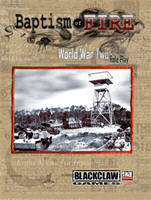Baptism of Fire: World War Two Role Play – RPG Game Review

Baptism of Fire: World War Two Role Play
Pub: Blackclaw Games $39.99.
Passed Inspection: Highly detailed Western Front and North Africa World War 2–role playing game, great technical information, wonderful atmosphere.
Failed Basic: Missing some obvious vehicles, overly complex at times, typos.
For gamers who aren’t into role-playing games, Baptism of Fire: World War Two Role Play can be adapted for extreme tactical fights using miniatures.
Baptism of Fire World War Two Role Play just released from Blackclaw Games is not just another World War 2 board game but an immersive experience into what it may have been like to be a soldier during the 1940s. The game offers a wealth of technical information – much of which I have never seen anywhere else – on everything from the average weight of the gear for British, American, German and Italian soldiers to the mix and type of high-explosive and armor-piercing ammunition carried on different types of tanks. For gamers who aren’t into role-playing games, Baptism of Fire: World War Two Role Play can be adapted for extreme tactical fights using miniatures. Miniatures also help role-play by showing relative positions and adding to the flavor of the game.
{default}For those unfamiliar with the term "role playing game (RPG)," these types of games are like a story or movie. One person becomes the storyteller for a group of players. The storyteller, called the Game Master or simply the GM, describes the set-up of the story (adventure) and then runs the encounters for the players – in effect, to use movie terms, the Game Master is the director and writer of the game and the players are the actors who tell the Game Master what they are doing. The fun of the game is directly related to the skill of the Game Master in “telling” the story. The players usually have to roll one or more die of various types (4 sided, 6 sided, 8 sided, 10 sided, 12 sided or 20 sided) and these die rolls affect the actions that the characters are attempting, such as scaling a wall or throwing a grenade.
While most role playing games are fantasy (Dungeons and Dragons), science fiction (Star Wars, Doctor Who, Traveler) or horror (Call of Cthulhu), Baptism of Fire: World War Two Role Play–writer Michael D. Burnside has attempted to re-create the triumph and tragedy of World War Two’s Western and North African fronts.
Players may be German, American, British or Italian. Each chooses his or her character’s wartime profession, i.e., infantry, heavy weapons specialist (machine gunners, artillerists, bazooka team members, etc.), medic, resistance fighter, scout (snipers, rangers, etc.) or armored teams (tank commanders, gunners, etc.). They then create their character’s skills and abilities (how strong your character is, how smart, how good a tank gunner, can he drive a half-track). They can also roll dice to see what their character did before the war – these “occupations” can be anything from bootlegger or petty thief to farmer or clerk. These backgrounds offer skills and more “meat” to flesh out the person you are playing in the game.
The rule book includes detailed information on weapons that characters may use or encounter, items they may have in their kit and many different types of vehicles (tanks, cars, armored cars, half-tracks, etc.) that characters may use, see, shoot at or be shot at from. Game play can involve such details as the chance for an item to break down or what happens if an armor-piercing shell blasts through the Sherman tank your character is driving. The game even charts what a shell hits as it passes through a tank.
For example : “My character is commanding a Stuart M3 with bolts in its hull holding down the armor. It gets hit with a shot from a German Panzer III AP shell but the shell glances off the armor. The crew is lucky the shell didn’t penetrate but, unfortunately, the shell did hit a bolt which flew into the crew compartment and hit the Gunner on his left leg. The gunner is screaming in agony, so I roll a morale check for my crew. The crew passes and doesn’t panic but the driver guns the engine and takes off at full speed, driving the tank behind some bocage for cover.”
While the game itself is fantastic to play or just to have as source material, there are a few problems. In designing the game, Burnside used the “open source” option from Wizards of the Coast, so in order to fully play the game and understand the rules, you must have a copy of any Wizards of the Coast D20 Role Playing Game such as the Dungeons and Dragons or Star Wars RPGs.
There are some typos in the rules, including one that can cause confusion between the terms “Stamina” and “Vitality” as they are used in the game. Also, some obvious vehicles such as the SdKfz 250 and 251 half-tracks as well as the Grant and Lee tanks are missing from the extensive vehicle lists. In this reviewer’s opinion, too much page count is given to overly complex artillery rules, especially in a highly tactical game in which each player plays no more than one to four people.
Nonetheless, this game is fun and detailed, an excellent first effort from writer Burnside and Blackclaw Games. Not to be missed for World War 2 gaming fans! Click here to read an interview with Michael Burnside about why he chose this subject for an RPG.
ACG Intel:






i love wold war 2